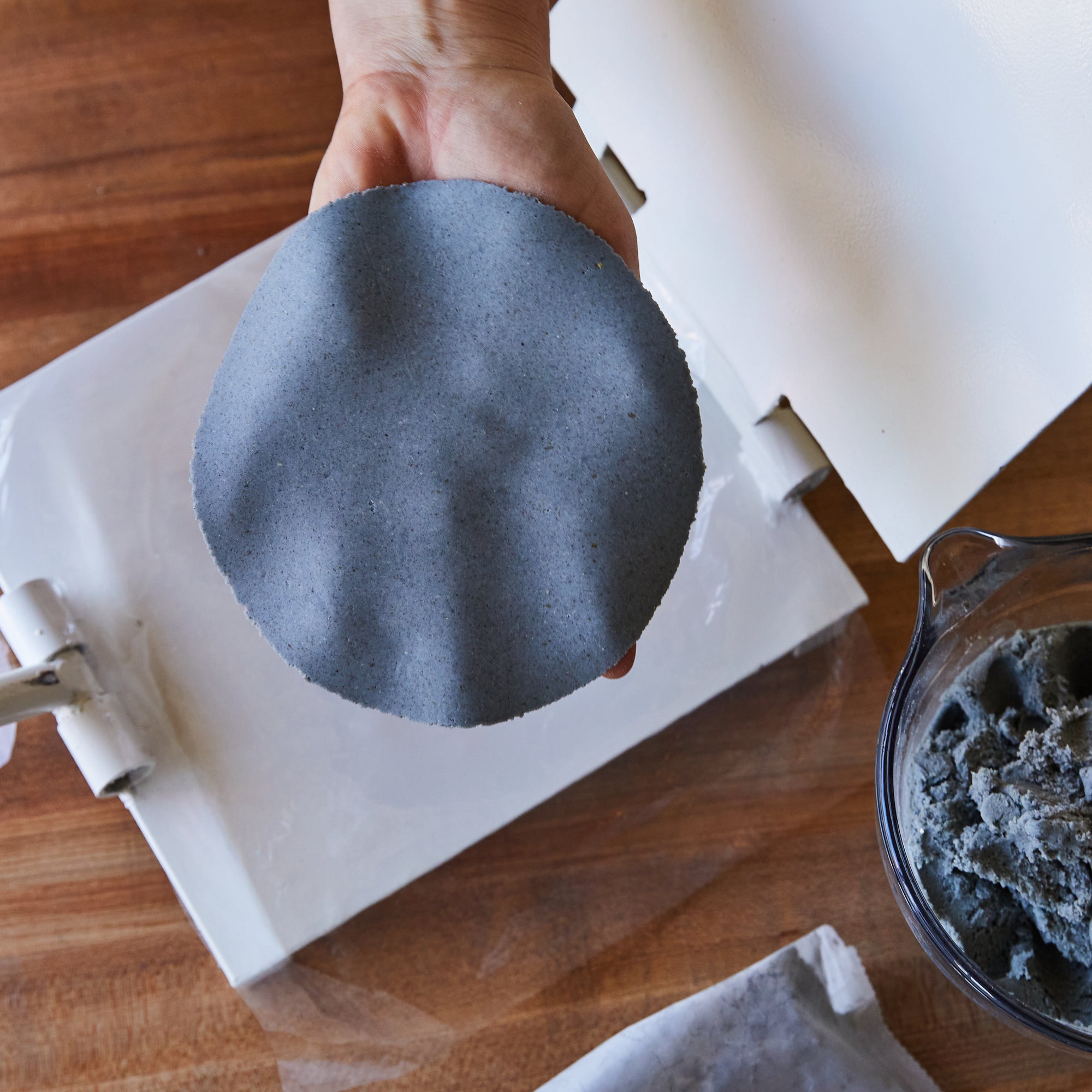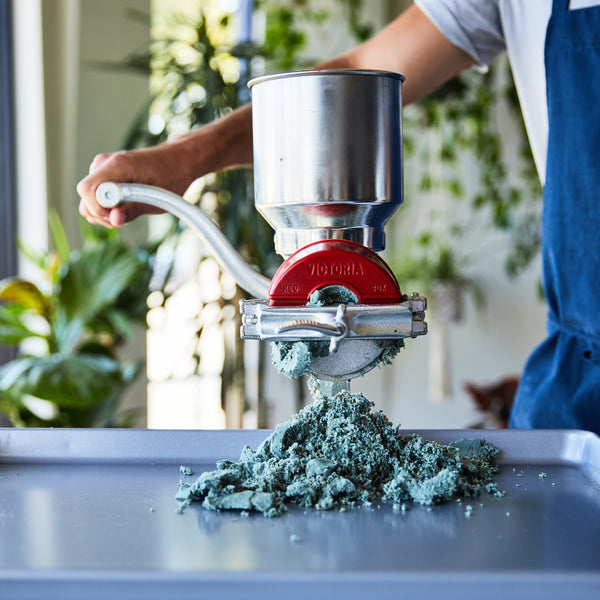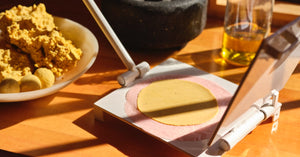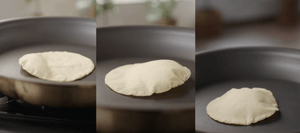All About Masa: A Guide to the Foundational Dough
All About Masa: A Guide to the Foundational Dough

August 14, 2022
Masienda was born out of a love for heirloom corn and the incredibly versatile dough that is masa. Since our founder, Jorge Gaviria, literally wrote the book on the topic, you'll find excerpts from MASA: Techniques, Recipes, and Reflections on a Timeless Staple peppered throughout this guide.
Shop MASA: Techniques, Recipes, and Reflections on a Timeless Staple
What is Masa?
Masa is the Spanish word for “dough.” In this case, we are referring to dough made from freshly ground nixtamalized corn or hominy. Jorge says:
We're mostly good with Merriam-Webster's definition, with a couple of exceptions:
So . . . Masa = corn + alkali + water. Dialed in a bit more, masa = corn cooked in a mixture of alkali and water, then ground into a dough.

Photograph by Graydon Herriott.
What's the Difference Between Masa and Masa Harina?
Masa harina (meaning “dough flour” in Spanish) is the flour used to make masa dough. To make masa preparada, or masa dough, from masa harina, you just add water and mix. Think of the difference between the two as if masa harina is the AP flour used for cookie dough, where masa is the cookie dough itself . . . except in this case, masa harina is made by dehydrating masa dough, making masa both the origin and the end point.
Where Does Masa Come From?
Masa plays an important role in the foods of Mesoamerica and beyond. According to MASA the book:
Who Invented Masa?
This question is a complicated one. There are few records that go back this many thousands of years to support masa's exact origin story, but there are some clues that point to specific places.
So far, the earliest evidence of equipment used specifically for masa making was discovered in Guatemala and dates back to 1500 to 1200 BCE. Archaeologists have additionally found earthenware colanders used to strain alkaline chemicals that date back to circa 1000 BCE.
Through such archaeological evidence, we know that the Maya, Aztecs, and others incorporated alkali, a basic chemical compound, into their corn’s preparation. They would boil the alkali materials—usually in the form of slaked lime or ash derived from crushed mussel and snail shells or wood—along with the corn in a pot of water. The alkali would help loosen the hulls, or pericarp, of the maize and break down the kernels’ cell walls."
Pretty brilliant, huh? The process of cooking corn with alkali is what we call nixtamalization.
Mesoamericans found infinite uses for this nixtamalized corn, establishing it as the foundation of their diet. . . .
In their whole state, the kernels could be used in traditional dishes like pozole. Alternatively, when stone-ground with a basalt metate and kneaded into a dough, the nixtamal became masa, which could be made into tortillas, tamales, gorditas, pupusas, atoles, and many other dishes, or used as a thickener for soups and stews.”
Photograph by Noah Forbes.
Is Masa Good for You?
The short answer is yes! Masa harina is high in calcium, vitamin B3, and protein, according to Epicurious.
The nixtamalization process is kind of like magic. Much of corn's nutritional goodness is inaccessible in its raw state, but the nixtamalization process unlocks corn's naturally occurring niacin (vitamin B3) content. The indigenous populations of North America discovered a technique that staved off diseases of malnutrition like pellagra (caused by niacin deficiency) and kwashiorkor (caused by protein deficiency).
A diet dependent on non-nixtamalized corn is not a healthy one. We know this because when Spanish conquistadors exported corn for global cultivation, they left behind the traditional farming and cooking practices that make it so beneficial to human health, and the corn-dependent populations in North America and Europe suffered the consequences.
Photograph by Noah Forbes.
Ways to Make Masa
There are almost as many ways to make masa as there are things to do with it. For the full lowdown, you’ll have to buy the book, but in short: you can make masa from masa harina and water, or from nixtamalized corn. You can nixtamalize with cal (slaked lime), ash, or tequesquite. You can grind by hand with a metate or a hand mill, or by machine with a molino (or Molinito!). And don’t get us started on all the varieties of corn you can use! (Just please don’t use sweet corn for masa for tortillas.)
Our Kernel to Masa YouTube tutorial series has everything you need to know about making masa from scratch. If you’re starting from masa harina, check out our recipe and video on the blog.

Photograph by Noah Forbes.
Types of Masa: Coarse vs Fine Masa
The first step before cooking your corn is to begin with the end, or final application, in mind.
You can grind (or purchase) masa with a smooth consistency for tortillas, or a coarser texture that’s best used for tamales. You can also prepare a more coarsely ground, lower moisture masa to use for frying tortillas (in applications like chips, tostadas, enchiladas and more). It’s worth noting that coarse-ground masa lasts a bit longer in the fridge (up to a week, versus smooth-ground masa’s three days). Make sure to cover all masa with a damp cloth and rehydrate when necessary.
8 Things You Can Do with Masa
So you’ve got your ball of masa prepped and staying hydrated (wrap it in a damp towel to keep it from drying out!). Here are some ideas of what to do next:
- Grab your tortilla press and make the best homemade tortillas for tacos, quesadillas, tostadas, tetelas, enchiladas and more.
- Press it into an even bigger shape for the large-format Oaxacan dish called the tlayuda: serve open-faced and topped, pizza-style, with beans, cheese, meat, salsa and more.
- Roll it into tiny balls, press an indent into each and boil them in salted water for perfect masa dumplings (called chochoyotes) to add to soups, stews or beans.
- Make a slightly bigger ball with a bigger indentation, fill with cheese or beans, roll and press between your hands to flatten before frying for pupusas.
- Whisk into boiling water and add whatever flavorings you’d like (cinnamon sticks, cocoa powder, coffee, sweeteners, fruit etc) for atole, a comforting breakfast drink.
- Wrap in a banana leaf or corn husk and steam for tamales.
- Shape into a small disc, cook on the comal then pinch the edges to create a ridge around one side to form a sope, a perfect vehicle for leftover meat, beans, cheese or salsa.
- Crumble into simmering milk, stirring frequently, for lusciously-textured grits. Don’t forget the butter!
Want to learn más about masa? Check out MASA: Techniques, Recipes, and Reflections on a Timeless Staple by Jorge Gaviria, available September 13 wherever books are sold.





